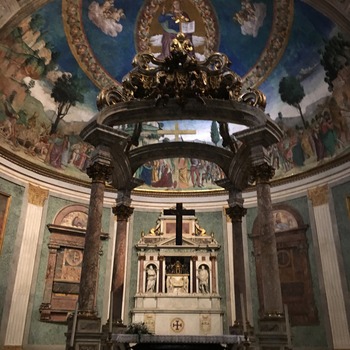The Basilica of the Santa Croce and Venerable Antonietta
-
July 3, 2025The Basilica of the Santa Croce (Holy Cross) in Gerusalemme (Jerusalem) is part of the route that many pilgrims visit while in Rome.
The name of the basilica comes from the story of St. Helena, the mother of the emperor Constantine. She received from our Lord a vision as to where the sacred relics of his crucifixion would be found in Jerusalem. The image in the apse of the church tells the story of how St. Helena traveled to Jerusalem and found the sacred relics. The True Cross was found by miracles attributed to it, as were some of the other sacred relics. Jesus is shown in the almond shape above the scene. If you take two circles and put them together overlapping, you get an almond shape in the middle. It’s a reference to the Trinity.
St. Helena returned to Rome with the sacred relics along with soil that she dispersed on the foundation of the basilica to be built to house the sacred relics. The basilica was consecrated in 325 AD. There is not much of the original structure that remains, having been rebuilt and restored throughout the centuries. The soil from Jerusalem is how the basilica’s name became Santa Croce in Jerusalem even though the basilica is in Rome just down the street from the pope’s cathedral, St. John Lateran.
The relics in the basilica include the name plate that was hung on the cross, two thorns from the Crown of Thorns, part of a nail, the index finger of St. Thomas and three pieces of the True Cross. To see the relics, the pilgrim ascends the stairs reading about each relic on signs that describe them before entering the chapel to pray before them. No photos are allowed in the chapel. It is reserved for veneration and prayer.
Another stop for pilgrims before ascending the staircase is a little room off to the left. This room holds the tomb of Antonietta Meo along with a display of her toys and letters. Antonietta was born in 1930, and this was her home parish. She suffered from bone cancer even having her leg amputated at five years old only to pass a year later. Catholic theologians have called her a “mystic” because she wrote “extraordinary” letters to Jesus Christ and Mary during her short life. One letter said, “Dear Jesus, I love you very much. I want to abandon myself in your hands [...] I want to abandon myself in your arms. Do with me what you want. [...] Help me with your grace. You help me, since without your grace, I can do nothing.” She wrote or dictated over 100 letters to Jesus or the Virgin Mary, describing “holy visions” in many of them.
Antonietta was declared Venerable in 2007 by Pope Benedict XVI. She is one to ask for intercession in the healing of sick children and for those who suffer from cancer.

